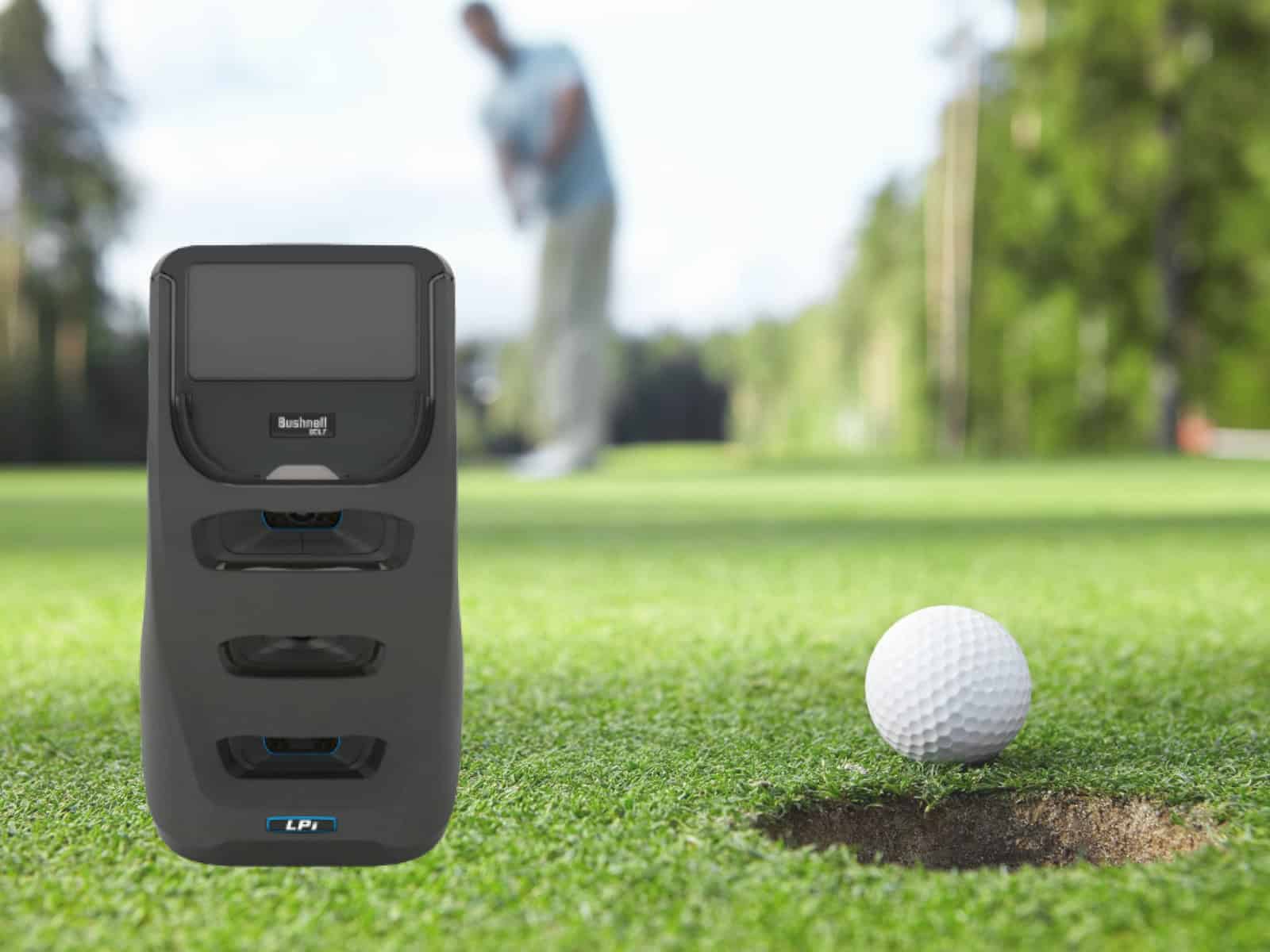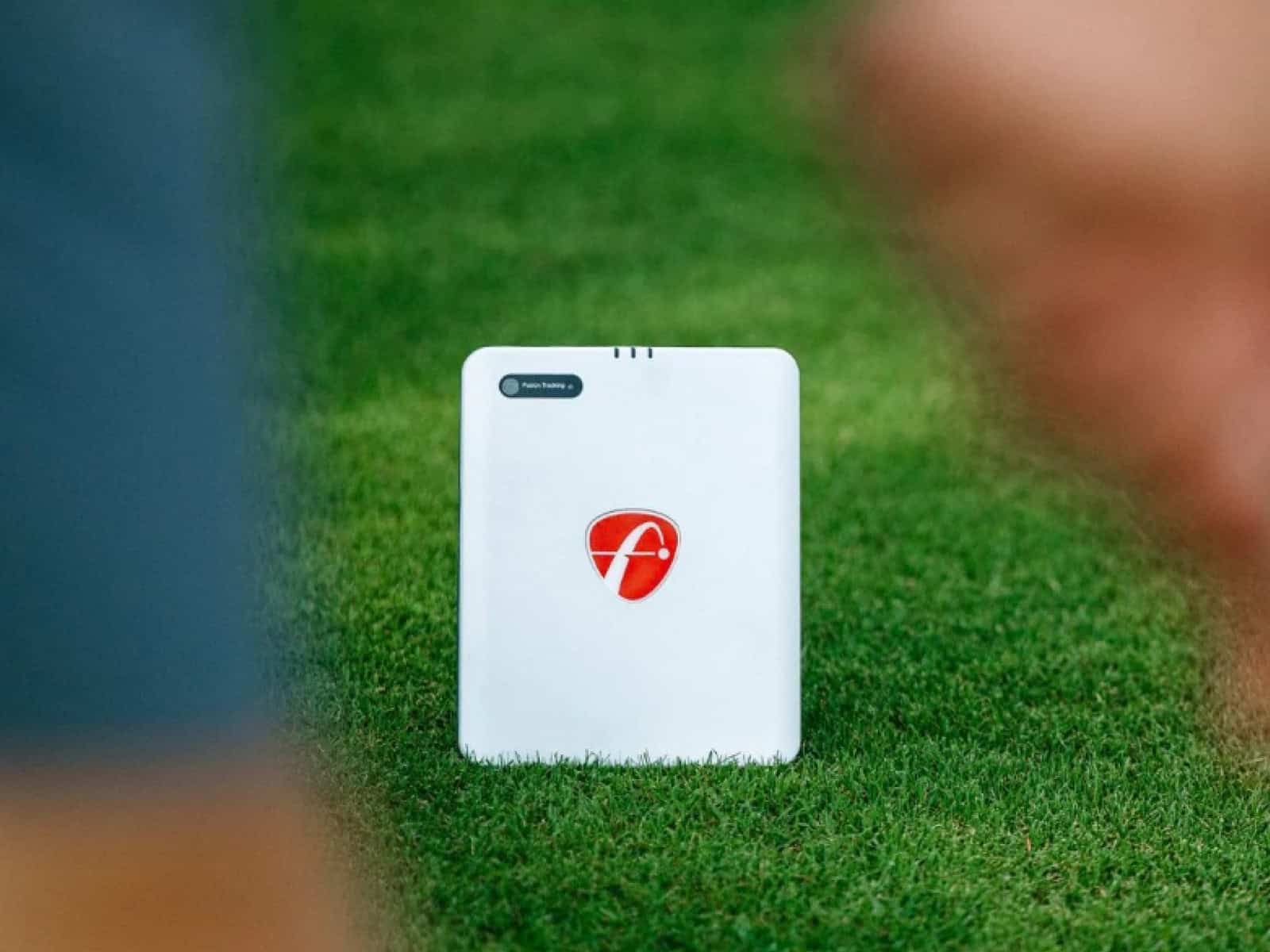The Bushnell LPi, priced at $2,799, enters the golf tech space with one clear goal—deliver pro-level performance at nearly half the cost of its premium rivals.
The LPi processes shot data in under one second. That’s more than just a number. In practice, it means less waiting, more swinging and real-time feedback that helps you improve.
We tested the LPi in a controlled indoor setup, evaluating its precision, responsiveness and overall experience. Every metric was recorded. Every feature was tested. No assumptions—just data and real results.
If you’re serious about golf simulation and want accuracy without the $6,000+ price tag, the Bushnell LPi could be the breakthrough your setup needs.
Unboxing and First Impressions
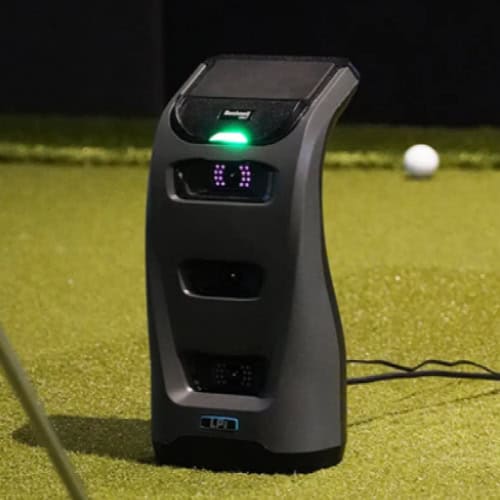
The LPi arrives in a well-structured box with minimal packaging waste. The contents are packed securely to prevent damage during transit. Here’s what we found inside:
- Bushnell LPi launch monitor
- USB-C cable (short length)
- Power adapter
- Alignment stick
- Reflective club face stickers
No onboard screen is included. Instead, it connects through a mobile or tablet app via Wi-Fi or USB-C.
Build Quality and Physical Design
The LPi feels solid in hand. It’s built with durable materials and has a compact footprint, perfect for fixed indoor setups. The unit features:
- A matte black finish that reduces glare under bright lights
- Non-slip feet to stay in place during use
- Clear LED indicators for power and network connection
Three high-speed cameras are integrated into the front housing, sitting flush with the frame. These cameras are the heart of the LPi system, quietly doing all the heavy lifting.
Setup and Ease of Use
Connecting the LPi to your device starts with a decision—USB-C or Wi-Fi. USB-C offers faster data transfer, while Wi-Fi adds flexibility. The device links to FSX software, which guides the setup.
Once connected, the LPi checks for firmware updates. Expect this to take several minutes. If you’re using a Windows PC, the software may prompt you to install the .NET framework. Some systems block this step, which can cause delays. Restarting the installation usually resolves it.
After updates complete, calibration begins. You place the alignment stick on the hitting surface. The cameras sync to this position, locking in your hitting zone. This zone must stay consistent during each session.
Everything runs through the FSX interface. There’s no physical screen, so a tablet or PC is required at all times. This keeps the LPi compact—but also means you’re reliant on external hardware.
Space and Environment Requirements
The recommended hitting area is at least 10 feet wide by 10 feet deep, with 8 feet of ceiling clearance. If your space is smaller, misreads become frequent.
Lighting matters too. The cameras perform best in neutral lighting. Bright backlight or deep shadows interfere with spin readings. A steady, evenly-lit room gives consistent results.
The LPi also requires constant power. It does not run on battery, which means your simulator must stay close to a power source. This limits placement but ensures stable performance.
Core Features and Technology
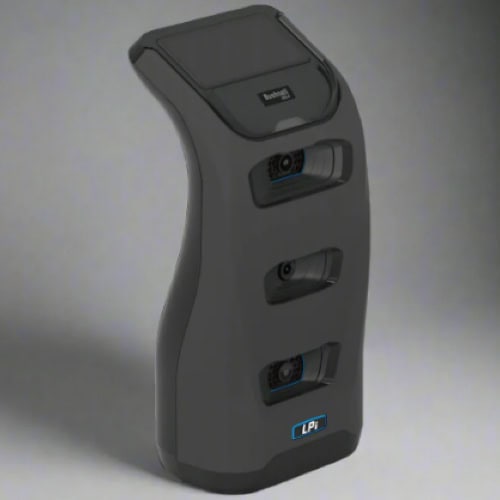
The Bushnell LPi excels in tracking with its three high-speed, high-resolution cameras. They work together to capture critical data points within milliseconds. Ball speed, launch angle, spin rate, carry distance, club path, and face angle are all monitored and delivered in real time.
The technology behind the LPi allows shot data to be recorded in under one second. This quick feedback helps understand your performance immediately, enabling quicker adjustments and continuous improvement. With high-precision tracking, the LPi ensures even small variations in your shot are captured accurately.
Software Compatibility and Subscriptions
The LPi integrates with top golf simulation software. It supports FSX Play, GSPro and E6 Connect, making it a flexible choice for different users.
The first year of FSX Gold subscription is included with your purchase, providing access to essential features and software updates. However, after the first year, an annual subscription is required to continue using FSX and access premium features. The ongoing cost of the subscription is something to consider when planning for long-term use. For golfers who want a deeper analysis of their performance and a broader range of features, this subscription ensures continuous access to cutting-edge simulation technology.
Usability and Display
The LPi operates through the Foresight Sports mobile or desktop app, meaning there is no onboard display. While this keeps the device compact, it also means you’ll always need a tablet or computer to view shot data. The app provides real-time feedback, with customizable data views that allow you to focus on the metrics that matter most to you.
Cloud-based session tracking and user profiles add an extra layer of convenience. All your data is stored securely, allowing you to analyze performance over time and track progress without having to manually log each session. This feature also means you can access your data remotely, which can be useful for coaches working with multiple players.
The app’s intuitive interface ensures that even those who aren’t tech-savvy can navigate the system easily. The smooth integration with simulation software and its user-friendly layout make the LPi an excellent choice for golfers of all skill levels.
Performance Testing and Accuracy

The true test of any golf launch monitor lies in its performance under real-world conditions. The Bushnell LPi was put through a series of hands-on testing scenarios to assess its reliability and accuracy across various shot types. This included full swing shots with the driver, mid-irons and wedges, as well as short game and putting assessments.
In each scenario, the LPi demonstrated a strong ability to capture the essential data points that golfers rely on for feedback. Whether executing powerful driver shots or delicate wedge plays, the LPi tracked ball speed, launch angle, spin rate, and carry distance with impressive consistency. Short game shots, including chips and delicate putts, were also tested to see how well the system could handle less powerful strokes. In all cases, the LPi provided relevant, actionable data almost instantly.
Real-World Accuracy Findings
When comparing the LPi’s performance to benchmark units such as the TrackMan and GCQuad, the Bushnell LPi proved to be surprisingly close. Ball speed and launch metrics were within 1–2% of the data collected from these premium devices. This level of accuracy is notable, especially considering the LPi’s more affordable price point under $3,000.
For those seeking reliable performance with less-than-perfect hits, the LPi’s spin and carry distance data remained stable. Even on mishits or shots with high spin rates, the system produced data that mirrored real-world expectations, delivering consistent results that you can trust for your practice sessions. It is rare to see a launch monitor at this price range perform with such precision under diverse conditions.
User Experience
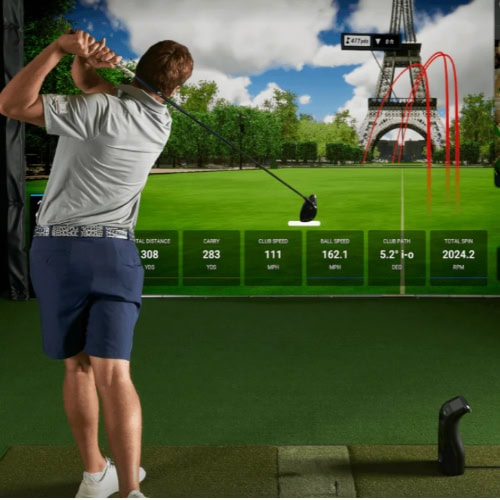
The Bushnell LPi’s user experience is centered around simplicity and efficiency. From the moment you power it on, the system is designed to provide smooth and fast feedback. The app, whether mobile or desktop, acts as the central hub for all interactions. Once the unit is connected to your device, there’s minimal lag between your shot and the data output. This quick turnaround time makes the LPi an excellent choice for those who require fast feedback for consistent practice.
The interface itself is clean and intuitive, with no steep learning curve. The app offers customizable views of your data, allowing you to focus on the most relevant metrics to your game, be it ball speed, spin rate or launch angle. You can easily adjust your settings and keep the data as simple or as complex as you need.
Strengths and Limitations
The following are things we loved about the Bushnell LPI, as well as what we believe could be improved in this impressive device:
Pros
- Fast Shot Processing: The LPi delivers real-time data with virtually no delay. You can take multiple shots in a short amount of time and get immediate feedback.
- Wide Hitting Zone: The device offers a generous hitting zone of approximately 7×10 inches, which allows for flexibility in your setup and positioning. Even when you don’t hit the center of the clubface, the data remains reliable.
- Solid Value: At a price point under $3,000, the LPi provides a high level of performance, making it a solid option for anyone who wants precise data without breaking the bank.
- Strong Integration with Software: The LPi’s compatibility with simulation software like FSX Play and GSPro makes it an ideal choice for those seeking a comprehensive setup.
Cons:
- Indoor Use Only: While the LPi excels in indoor environments, it’s limited to these spaces and cannot be used outdoors. For those seeking versatility, this could be a dealbreaker.
- Short USB-C Cable: The included USB-C cable is relatively short, which could be inconvenient depending on your setup. You may need an extension or a different cable if you’re working in a larger space.
- Setup May Challenge Non-Technical Users: The initial setup requires some familiarity with software installation, and users who aren’t technically inclined may find the process a bit daunting, especially with potential issues like .NET framework installations.
Comparisons with Alternatives
We have also compared the LPI to some of its closest competitors. Here are our findings:
Bushnell LPi vs. SkyTrak+
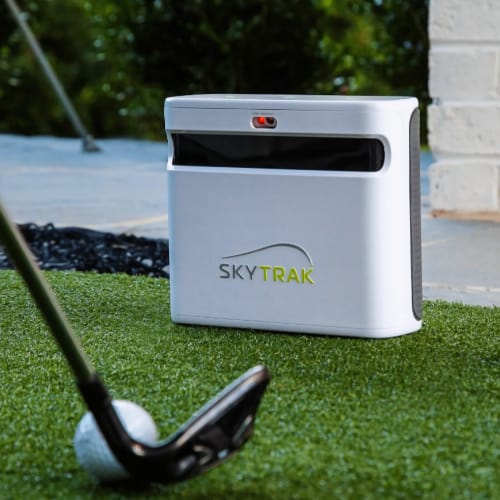
One of the main differences between the LPI and Skytrak+ lies in the speed at which data is delivered. The LPi boasts a faster shot-to-data cycle, meaning you experience a more immediate feedback loop.
However, the SkyTrak+ has its own advantages. Notably, it supports outdoor use, which gives more versatility if you prefer to practice on an open course rather than in an indoor simulator. For users who are set on indoor-only training, though, the LPi’s performance is a step above.
In terms of accuracy, the LPi outperforms the SkyTrak+, especially when it comes to mishits. The LPi’s camera-based tracking system is more precise, delivering consistently reliable data even on off-center hits.
Bushnell LPi vs. FlightScope Mevo+

Another comparison worth considering is between the Bushnell LPi and the FlightScope Mevo+, a radar-based system. While the LPi utilizes camera-based technology, the Mevo+ relies on radar waves to track ball and club data. Each technology has its pros and cons, but for indoor simulation, the LPi has an advantage in smaller spaces.
The Mevo+ is known for its portability, making it the go-to option for golfers who need flexibility in their setups or wish to take their device outside. The LPi is more specialized for stationary, indoor setups.
Ideal Use Cases
The Bushnell LPi is a versatile tool, but like any piece of technology, its true value shines in specific scenarios. Understanding the ideal use cases for the LPi can help you make a well-informed decision.
Indoor Golf Simulator Setups for Serious Amateurs
For those dedicated to improving their game indoors, the LPi is a powerful ally. Its precise camera-based tracking system provides highly accurate data, which is essential for fine-tuning your swing.
Serious amateurs looking to build or upgrade their sims will find the LPi a cost-effective alternative to pricier professional-grade systems. Its sub-$3,000 price point allows you to set up a high-quality simulator without breaking the bank.
Coaches or Facilities Needing Consistent, High-Quality Shot Data
For golf coaches and facilities that require detailed, consistent shot data for players of all skill levels, the Bushnell LPi is an excellent choice. The system tracks a variety of metrics that are essential for coaching, from carry distance to club path. The ability to quickly access this data and adjust teaching strategies in real time is a significant advantage.
The LPi integrates well with popular simulation software, further streamlining the experience for both coach and player. This allows coaches to focus on what matters most: improving their students’ performance.
If you’re a serious golfer who can’t justify spending over $10,000 on high-end systems, the Bushnell LPi presents an attractive solution. At a fraction of the price, you get fast, reliable data and solid integration with leading simulation software. The LPi shines in its price range, making it an ideal option for those who want pro-level feedback without a premium price tag.
Where to Buy?
Given its growing popularity among golfers, the LPi is available through a variety of trusted channels, each offering different advantages.
You can get the LPI directly from Bushnell’s official website; otherwise, we suggest checking our recommended online retailers:
Financing and Discounts
Whether you’re buying from the official website or an authorized retailer, check if there are financing options available. The LPi’s price point makes it a significant investment, so many retailers offer flexible payment plans. Keep an eye out for seasonal discounts or promotional codes, especially around major shopping events like Black Friday or Cyber Monday.
Frequently Asked Questions
When considering the Bushnell LPi, many potential buyers have specific questions regarding its performance, compatibility and usage. Addressing these concerns can help you make a well-informed decision.
Is the Bushnell LPi accurate enough for professional-level training?
Yes, the Bushnell LPi is more than capable of delivering accuracy that meets professional standards. Its camera-based tracking system provides precise measurements that are consistent with premium launch monitors, such as the GC3.
What software is compatible with the Bushnell LPi?
The LPi integrates seamlessly with multiple popular golf simulation platforms. It supports FSX Play, FSX 2020, GSPro, and E6 Connect. Each software offers different features, so depending on your needs, you’ll find the right fit.
Can the LPi be used outdoors?
Unfortunately, the Bushnell LPi is designed exclusively for indoor use. The camera-based technology does not function reliably outdoors, where lighting and environmental conditions can cause inaccuracies. Also, it doesn’t have a built-in battery, so it needs a constant power source.
What are the minimum PC specs for running FSX software smoothly?
To run the FSX software without hiccups, ensure your PC meets the following specifications:
– CPU: Intel i7 (12th or 14th Gen)
– GPU: NVIDIA RTX 3070 or higher
– RAM: 16–32GB
– OS: Windows 10 or later
Is a subscription required for the LPi?
Yes, a subscription is required for ongoing access to certain features and simulation platforms. The first year of the FSX Gold subscription is included with the purchase of the LPi. However, after that, you will need to pay an annual subscription fee to continue using the software and premium data features.
Final Thoughts
The Bushnell LPi launch monitor offers precision, speed and affordability. While its price point is significantly lower than many high-end competitors, it delivers performance that rivals premium models, making it an appealing choice for serious indoor golfers.
For those building a golf simulator on a budget, the LPi provides accurate shot data, reliable software integration and a solid user experience, all for under $3,000. To see how it stacks up against the Bushnell Launch Pro, check out our detailed Bushnell Launch Pro vs. LPi comparison.
However, it’s important to remember that the LPi is designed specifically for indoor use. Its reliance on external software and lack of an onboard display may be limitations for some users. Still, for indoor setups, especially where space and budget are key factors, it offers a competitive edge without the high price tag of other high-end launch monitors.
If you have any questions or comments, feel free to contact our team via email or in the comments section below.
Thanks for reading!


